Suitable Re-Use of Abandoned Quarries for Restoration and Conservation of the Old City of Salamanca—World Heritage Site
Abstract
1. Introduction
2. Materials and Methods
2.1. Martinamor Granite
2.2. Methods
3. Results and Discussion
3.1. Quarries and Extraction Techniques
3.2. Fracturing and Resources Evaluation
3.3. The Need for a Geoconservation Proposal
4. Conclusions
Author Contributions
Funding
Acknowledgments
Conflicts of Interest
References
- Luodes, N.; Panova, E.; Bellopede, R. Characterization of natural stone material used in the Nordic eastern urban and costal environment. Environ. Earth Sci. 2017, 76, 328. [Google Scholar] [CrossRef]
- Freire-Lista, D.M.; Fort, R. Historical City Centres and Traditional Building Stones as Heritage: Barrio de las Letras, Madrid (Spain). Geoheritage 2019, 11, 71–85. [Google Scholar] [CrossRef]
- Menningen, J.; Siegesmund, S.; Lopes, L.; Martins, R.; Sousa, L. The Estremoz marbles: An updated summary on the geological, mineralogical and rock physical characteristics. Environ. Earth Sci. 2018, 77, 191. [Google Scholar] [CrossRef]
- Pereira, D. Natural stone and World Heritage: Salamanca (Spain); CRC Press: Bota Raton, FL, USA, 2019. [Google Scholar]
- Yang, Y.-Y.; Xu, Y.-S.; Shen, S.-L.; Yuan, Y.; Yin, Z.-Y. Mining-induced geo-hazards with environmental protection measures in Yunnan, China: An overview. Bull. Eng. Geol. Environ. 2015, 74, 141–150. [Google Scholar] [CrossRef]
- Essalhi, A.; Essalhi, M.; Toummite, A. Environmental impact of mining exploitation: A case study of some mines of barite in the Eastern Anti-Atlas of Morocco. J. Environ. Prot. 2016, 7, 1473–1482. [Google Scholar] [CrossRef]
- Ozcelik, M. Environmental pollution and its effect on water sources from marble quarries in western Turkey. Environ. Earth. Sci. 2016, 75, 796. [Google Scholar] [CrossRef]
- OECD. Managing environmental and health impacts of uranium mining; NEA: Paris, France, 2014. [Google Scholar]
- Mensah, A.K.; Mahiri, I.O.; Owusu, O.; Mireku, O.D.; Wireko, I.; Kissi, E.A. Environmental impacts of mining: A study of mining communities in Ghana. Appl. Ecol. Env. Res. 2015, 3, 81–94. [Google Scholar]
- Pereira, D.; Gimeno, A.; del Barrio, S. Piedra Pajarilla: A candidacy as a Global Heritage Stone Resource for Martinamor granite. Geol. Soc. London, Spéc. Publ. 2014, 407, 93–100. [Google Scholar] [CrossRef]
- Cooper, B.; Marker, B.; Pereira, D.; Schouenborg, B. Establishment of the “Heritage Stone Task Group” (HSTG). Episodes 2013, 36, 8–10. [Google Scholar]
- Pereira, D.; Cooper, B.J. Building stone as a part of a World Heritage Site: ‘Piedra Pajarilla’ Granite and the city of Salamanca, Spain. Geol. Soc. London, Spéc. Publ. 2013, 391, 7–16. [Google Scholar] [CrossRef]
- Díez Balda, M.A. El Complejo Esquisto-Grauvaquico, las series Paleozoicas y la estructura Hercínica al Sur de Salamanca; Ediciones Universidad de Salamanca: Salamasca, Spain, 1986; 162p. [Google Scholar]
- Díez Balda, M.A.; Vegas, R.; González Lodeiro, F. Central Iberian Zone. In Pre-Mesozoic Geology of Iberia; Dallmeyer, R.D., Martinez-Garcia, E., Eds.; Springer: Berlín, Germany, 1990; pp. 172–188. [Google Scholar]
- Pereira, M.D.; Rodríguez-Alonso, M.D. Duality of cordierite granites related to melt-restite segregation in the Peña Negra Anatectic Complex, central Spain. Can. Mineral. 2000, 38, 1329–1346. [Google Scholar]
- López Plaza, M.; Sánchez, M.G.; Iñigo, A.C. La utilización del leucogranito turmalinífero de Martinamor en los monumentos de Salamanca y Alba de Tormes. Stud. Geol. Salmant. 2007, 43, 247–280. [Google Scholar]
- UNE EN 12440 Natural Stone: Denomination Criteria; The National Standards Authority of Ireland: Dublin, Ireland, 2008.
- Sousa, L.; Siegesmund, S.; Wedekind, W. Salt weathering in granitoids: An overview on the controlling factors. J. Environ. Earth Sci. 2018, 77, 502. [Google Scholar] [CrossRef]
- Cardozo, N.; Allmendinger, R.W. Spherical projections with OSXStereonet. Comput. Geosci. 2013, 51, 193–205. [Google Scholar] [CrossRef]
- Richard Allmendinger’s Home Page. Available online: https://personalpages.manchester.ac.uk/staff/Richard.Allmendinger/ (accessed on 22 May 2019).
- Sousa, L.M.O.; Oliveira, A.S.; Alves, I.M.C. Influence of fracture system on the exploitation of building stones: The case of the Mondim de Basto granite (north Portugal). Environ. Earth Sci. 2016, 75, 39. [Google Scholar] [CrossRef]
- Palmström, A. The volumetric joint count—a useful and simple measure of the degree of jointing. In Proceedings of the 4th international congress of IAEG, New Delhi, India, 10–15 December 1982; pp. 182, 221–228. [Google Scholar]
- Heldal, T. Constructing a quarry landscape from empirical data. General perspectives and a case study at the Aswan west bank, Egypt. In QuarryScapes: Ancient stone quarry landscapes in the Eastern Mediterranean; Abu-Jaber, N., Bloxam, E.G., Degryse, P., Heldal, T., Eds.; Geological Survey of Norway Special Publication: Trondheim, Norway, 2009; Volume 12, pp. 125–153. [Google Scholar]
- Wootton, W.; Russell, B.; Rockwell, P. Stoneworking tools and toolmarks (version 1.0). The Art of Making in Antiquity: Stoneworking in the Roman World. 2013. Available online: http://www.artofmaking.ac.uk/content/essays/2-stoneworking-tools-and-toolmarks-w-wootton-b-russell-p-rockwell/ (accessed on 5 February 2019).
- Hori, Y. Ancient Quarry Techniques in the Ptolemaic Period in the Middle Egypt. In Proceedings of the XVII International Congress of Classical Archaeology, Roma, Italy, 22–26 September 2008. [Google Scholar]
- Harrell, J.A.; Storemyr, P. Ancient Egyptian quarries—an illustrated overview. In QuarryScapes: Ancient stone quarry landscapes in the Eastern Mediterranean; Abu-Jaber, N., Bloxam, E.G., Degryse, P., Heldal, T., Eds.; Geological Survey of Norway Special Publication: Trondheim, Norway, 2009; Volume 12, pp. 7–50. [Google Scholar]
- Coli, M.; Rosati, G.; Pini, G.; Baldi, M. The Roman quarries at Antinoopolis (Egypt): Development and techniques. J. Archaeol. Sci. 2011, 38, 2696–2707. [Google Scholar] [CrossRef]
- Verhoeven, G.; Taelman, D.; Vermeulen, F. Computer vision-based orthophoto mapping of complex archaeological sites: The ancient quarry of Pitaranha (Portugal-Spain). Archaeometry 2012, 54, 1114–1129. [Google Scholar] [CrossRef]
- Carfora, P.; Di Luzio, E. Archaeomorphological and Geological Studies on the Ancient Appian Way at the Aurunci Pass: Multidisciplinary Approaches for the Investigation of Ancient Quarries Siting and Exploitation. In Proceedings of the 3rd International Landscape Archaeology Conference, Rome, Italy, 17–20 September 2014. [Google Scholar]
- Hockensmith, C.D. Archaeological Investigations at the Shrull Lime Kiln Near Russellville, Logan County, Kentucky. In Current Archaeological Research in Kentucky; Mills, E.N., Williamson, R.V., Davis, R.D., Eds.; Kentucky heritage council: Frankfort, KY, USA, 2007; Volume 9, pp. 1–26. [Google Scholar]
- Gage, J. Osgood Graphite Mine, Nelson NH Site Report. 2002. Available online: http://www.stonestructures.org/html/graphite_mine.html (accessed on 6 February 2019).
- Gage, M.; Gage, J. The art of splitting stone. Early Rock Quarrying Methods in Pre-Industrial New England; Powwow River Books: Amesbury, MA, USA, 2005. [Google Scholar]
- Sousa, L.M.O. Granite fracture index to check suitability of granite outcrops for quarrying. Eng. Geol. 2007, 92, 146–159. [Google Scholar] [CrossRef]
- Pereira, D.; Marker, B. The Value of Original Natural Stone in the Context of Architectural Heritage. Geosciences 2016, 6, 13. [Google Scholar] [CrossRef]
- Freire-Lista, D.M.; Fort, R.; Varas-Muriel, M.-J. Alpedrete granite (Spain). A nomination for the “Global Heritage Stone Resource” designation. Episodes 2015, 38, 106–133. [Google Scholar]
- Freire-Lista, D.M.; Fort, R.; Varas-Muriel, M.-J. San Pedro leucogranite from A Coruña, Northwest of Spain: Uses of a heritage stone. Energy Procedia 2016, 97, 554–561. [Google Scholar] [CrossRef][Green Version]
- Traditional building stone in Madrid monuments. Available online: https://www.madrimasd.org/English/Science-Society/scientific-heritage/Geomonumental-Routes/madrid/default.asp (accessed on 8 May 2019).
- Careddu, N.; Siotto, G.; Siotto, R.; Tilocca, C. From landfill to water, land and life: The creation of the Centre for stone materials aimed at secondary processing. Resour. Policy 2013, 38, 258–265. [Google Scholar] [CrossRef]
- Carrión Mero, P.; Herrera Franco, G.; Briones, J.; Caldevilla, P.; Domínguez-Cuesta, M.; Berrezueta, E. Geotourism and Local Development Based on Geological and Mining Sites Utilization, Zaruma-Portovelo, Ecuador. Geoscience 2018, 8, 205. [Google Scholar] [CrossRef]
- Prosser, C.D. Geoconservation, Quarrying and Mining: Opportunities and Challenges Illustrated Through Working in Partnership with the Mineral Extraction Industry in England. Geoheritage 2018, 10, 259–270. [Google Scholar] [CrossRef]
- Guerra Garrido, R. El año del wólfram, 1st ed.; Catedra Ediciones: Madrid, Spain, 1984; 354p. [Google Scholar]
- Wilson, R. A small death in Lisbon; Harper Collings Publishers: London, UK, 1999; 440p. [Google Scholar]
- IGME Point of Geological Interest. Available online: http://info.igme.es/ielig/LIGInfo.aspx?codigo=CIs027 (accessed on 8 May 2019).
- Baczyńska, E.; Lorenc, M.W.; Kaźmierczak, U. The Landscape Attractiveness of Abandoned Quarries. Geoheritage 2018, 10, 271. [Google Scholar] [CrossRef]
- Kaźmierczak, U.; Lorenc, M.W.; Strzałkowski, P. The analysis of the existing terminology related to a post-mining land use: A proposal for new classification. Environ. Earth Sci. 2017, 76, 693. [Google Scholar] [CrossRef]
- Cross, A.T.; Young, R.; Nevill, P.; McDonald, T.; Prach, K.; Aronson, J.; Wardell-Johnson, G.W.; Dixon, K.W. Appropriate aspirations for effective post-mining restoration and rehabilitation: A response to Kaźmierczak et al. Environ. Earth Sci. 2018, 77, 256. [Google Scholar] [CrossRef]
- Goette, H.R.; Pajor, F. Eduard Schaubert’s travel notes on Southern Euboea in May 1847. Mediterr. Archaeol. Archaeom. 2010, 3, 63–64. [Google Scholar]
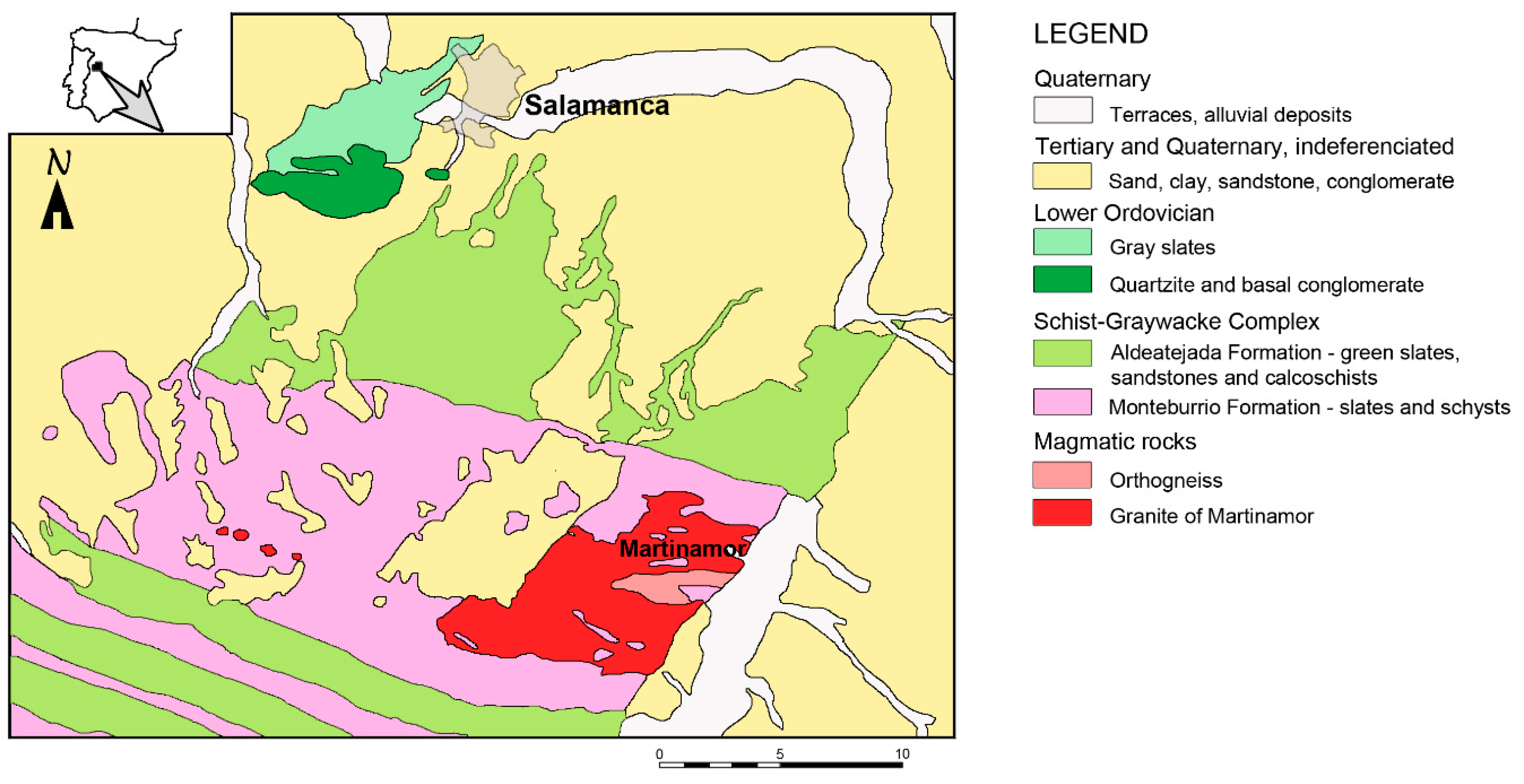
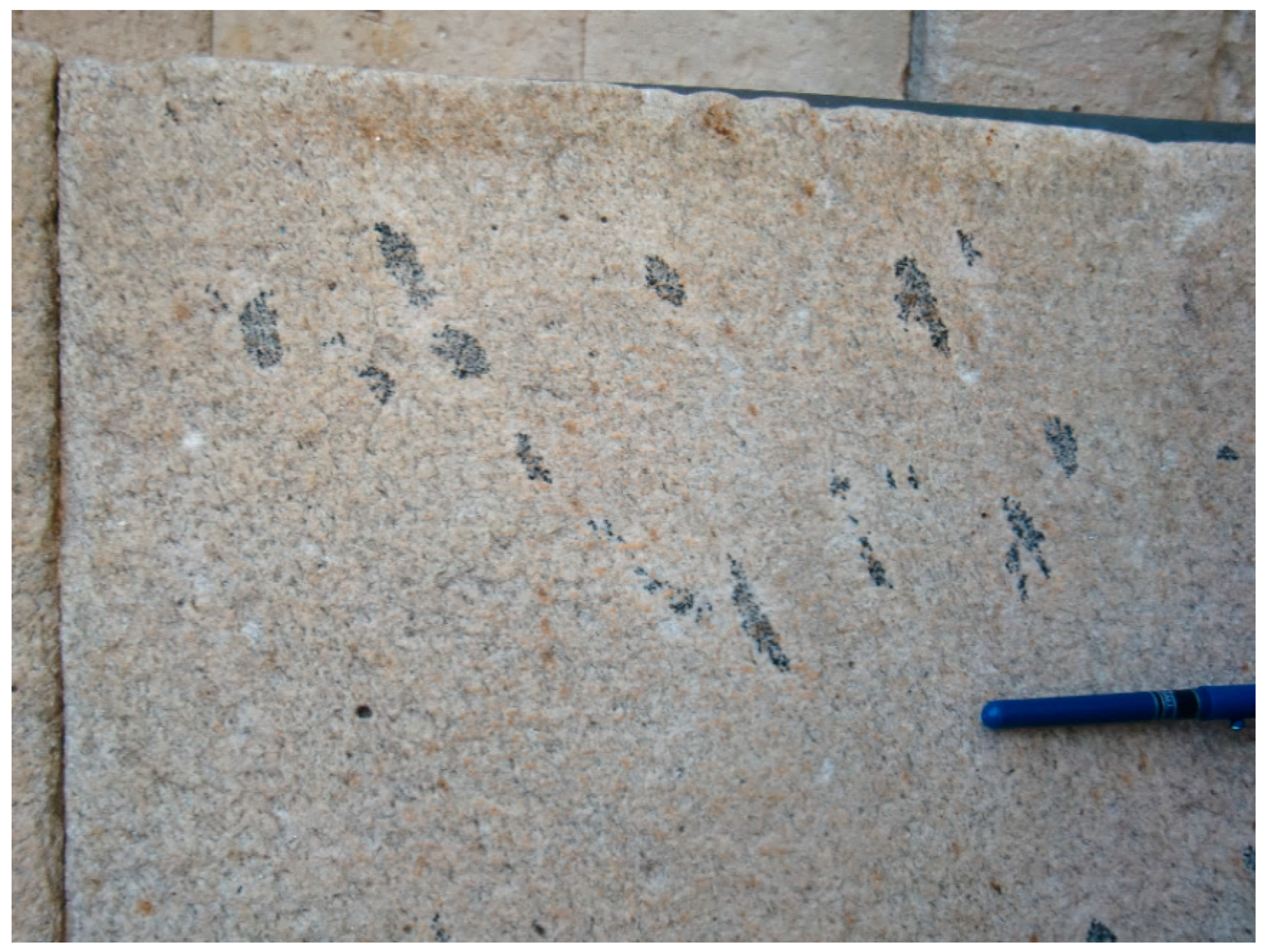
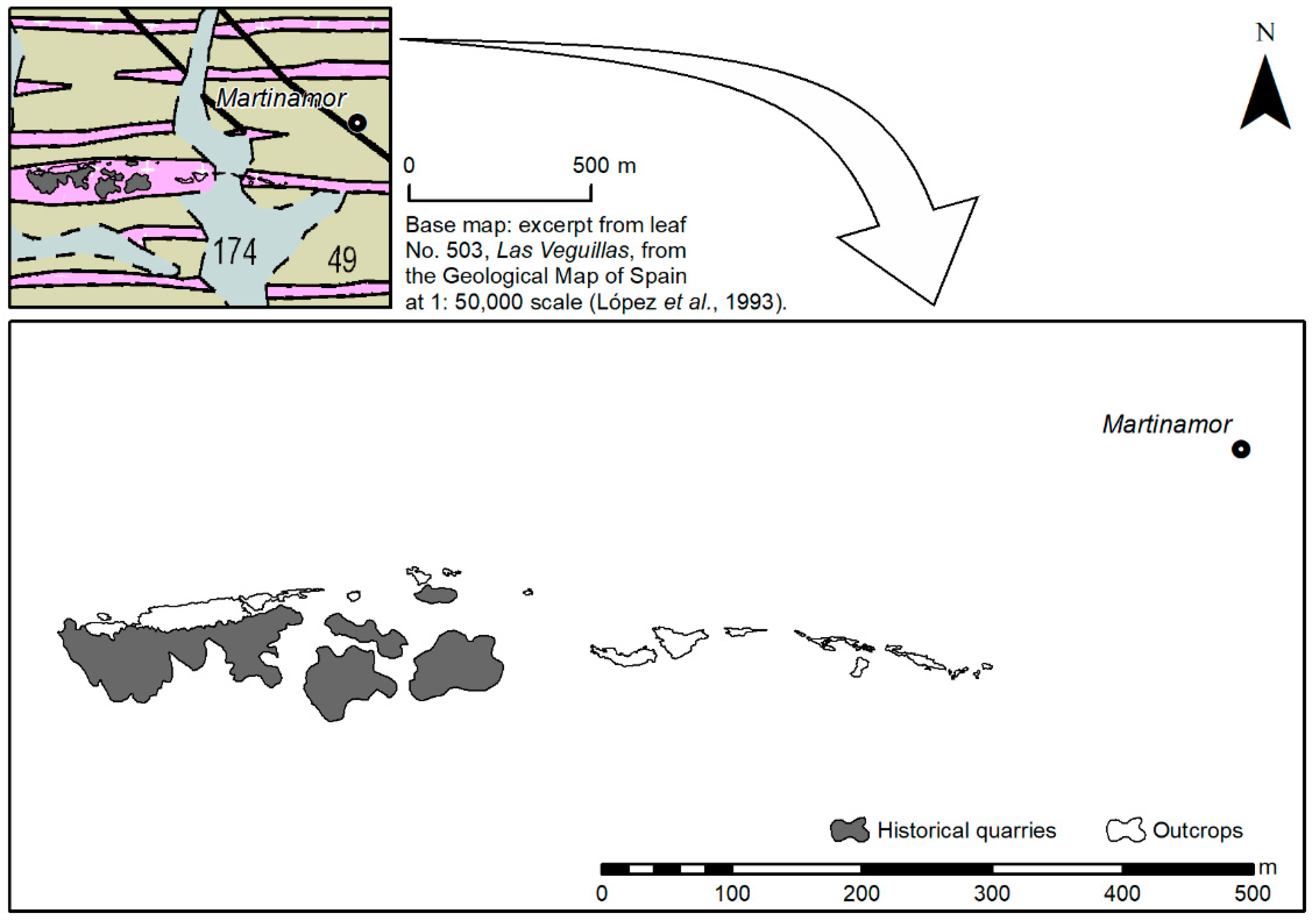
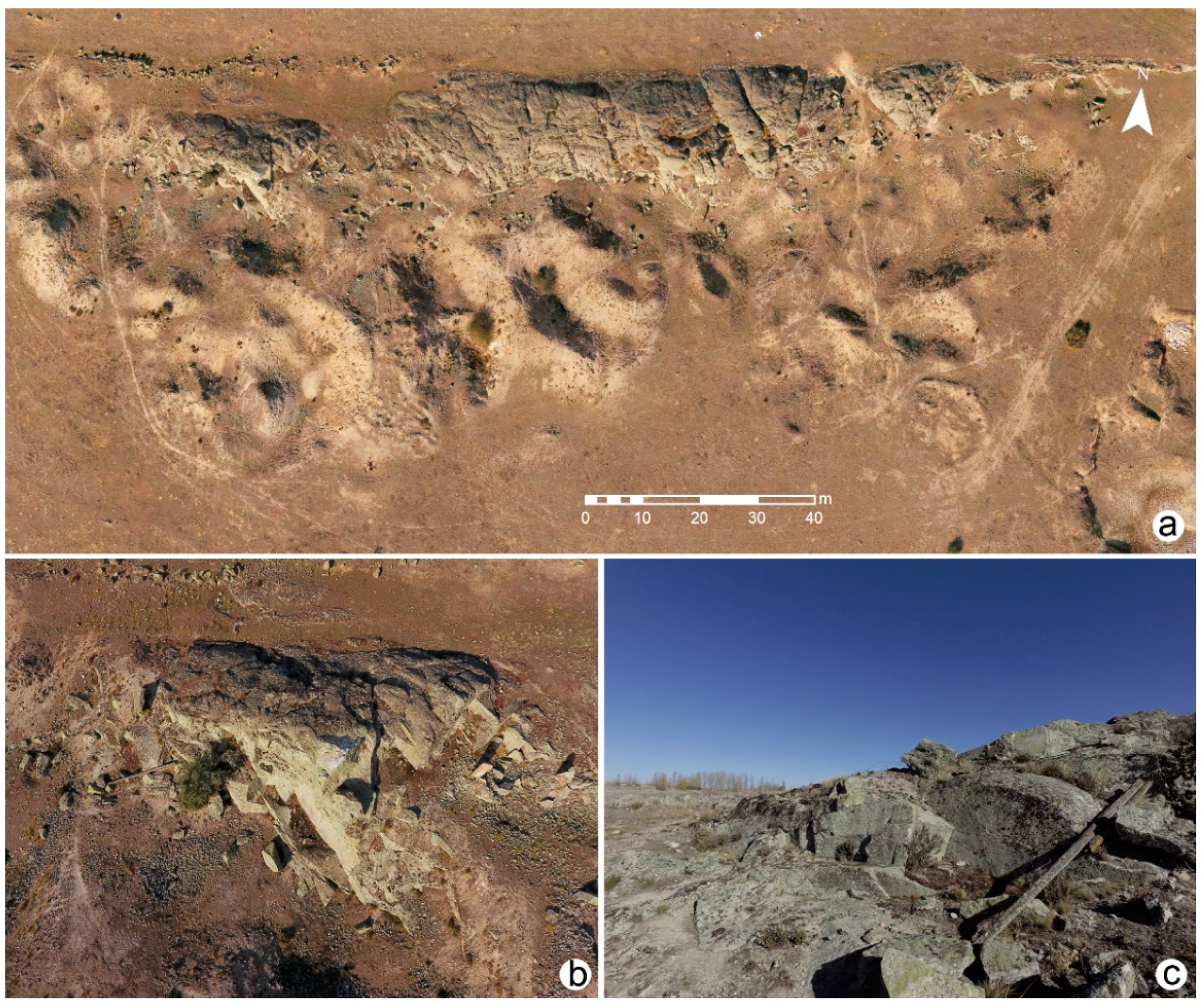
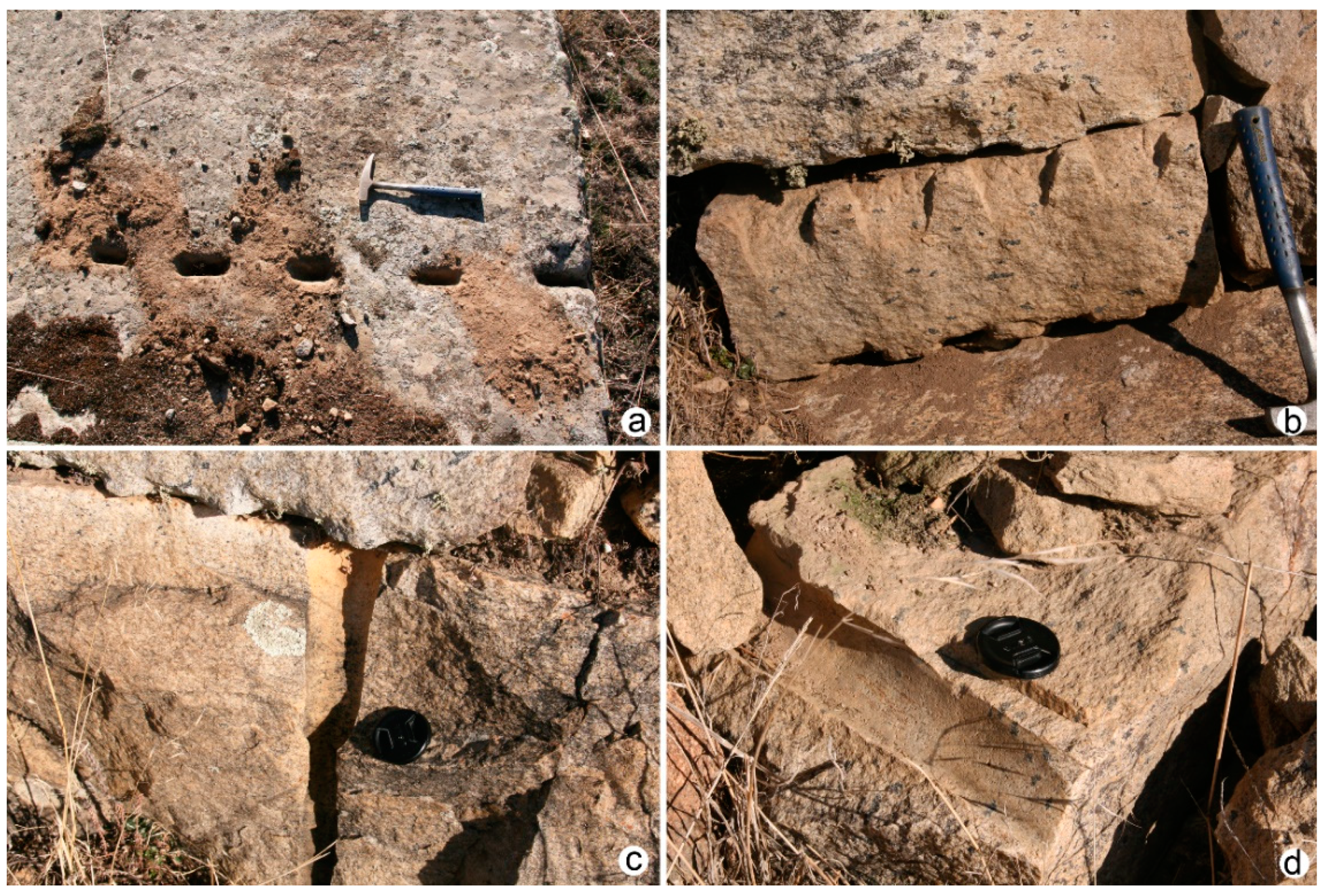
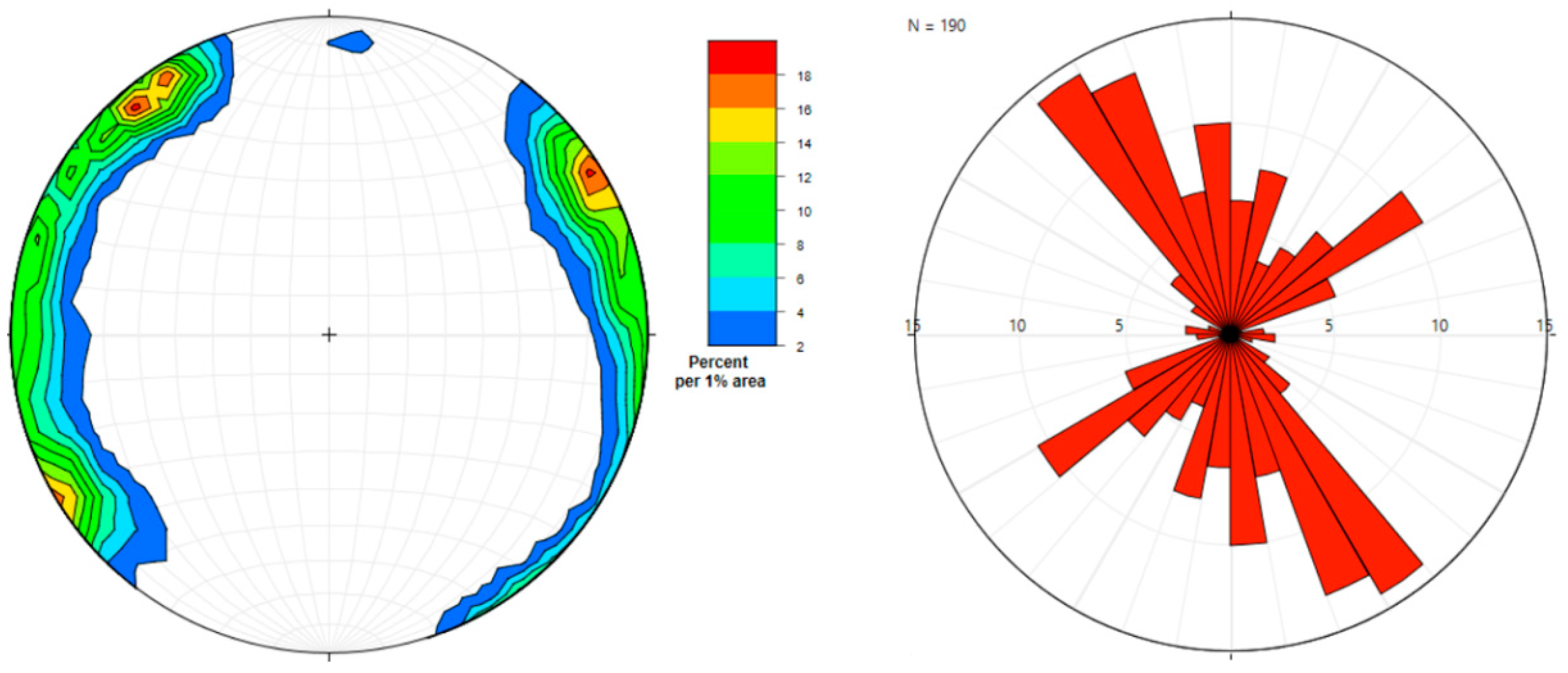
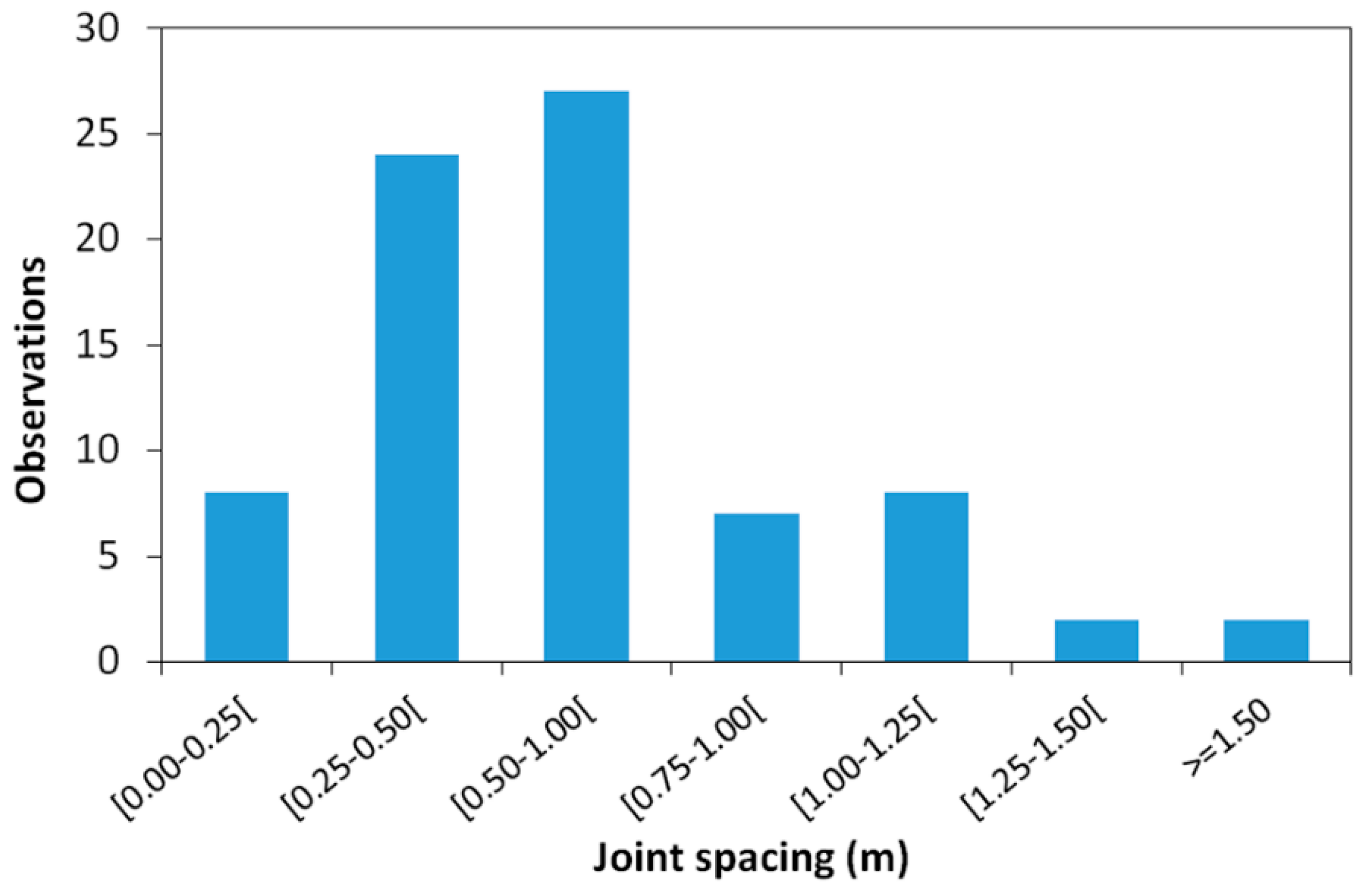
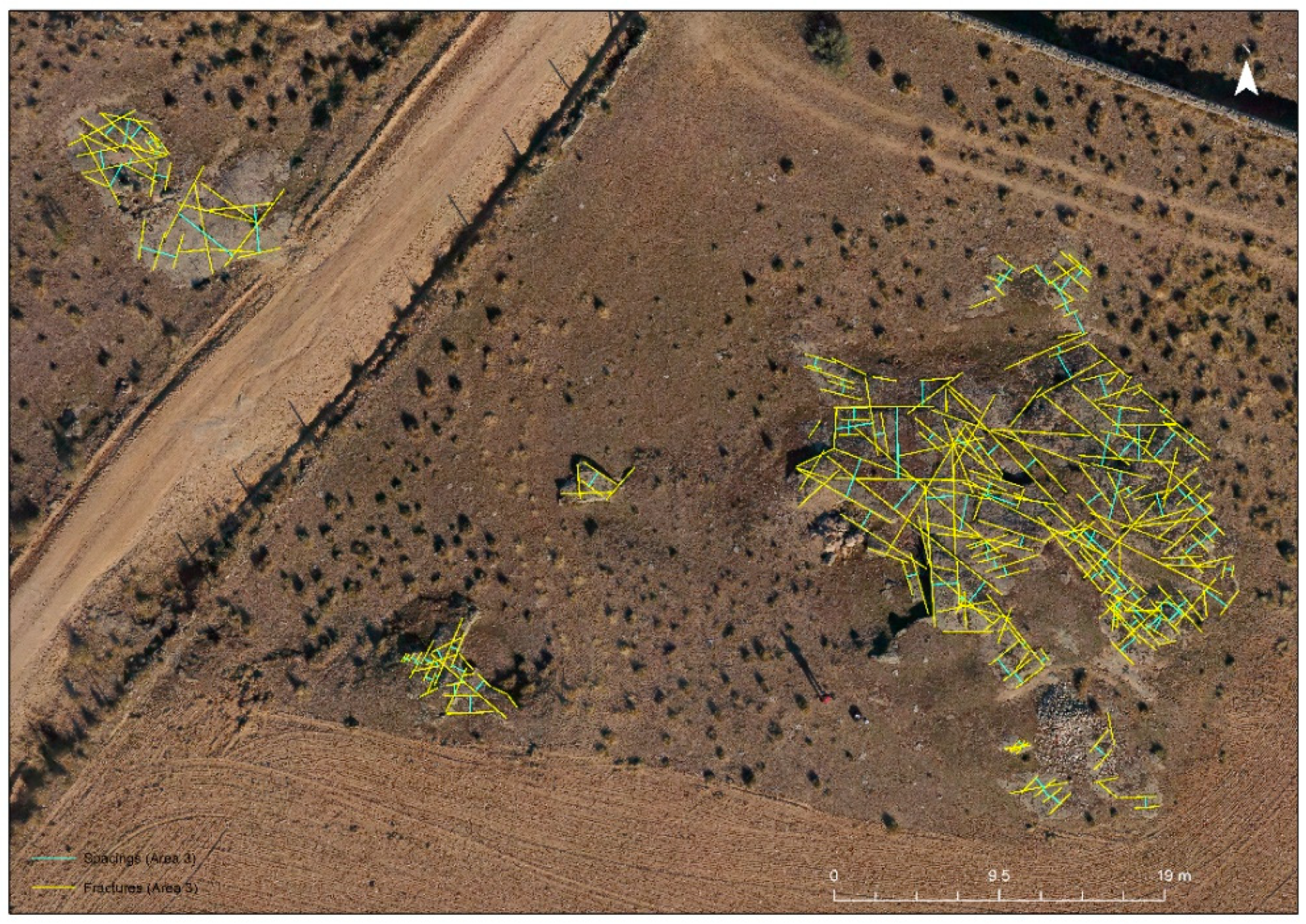
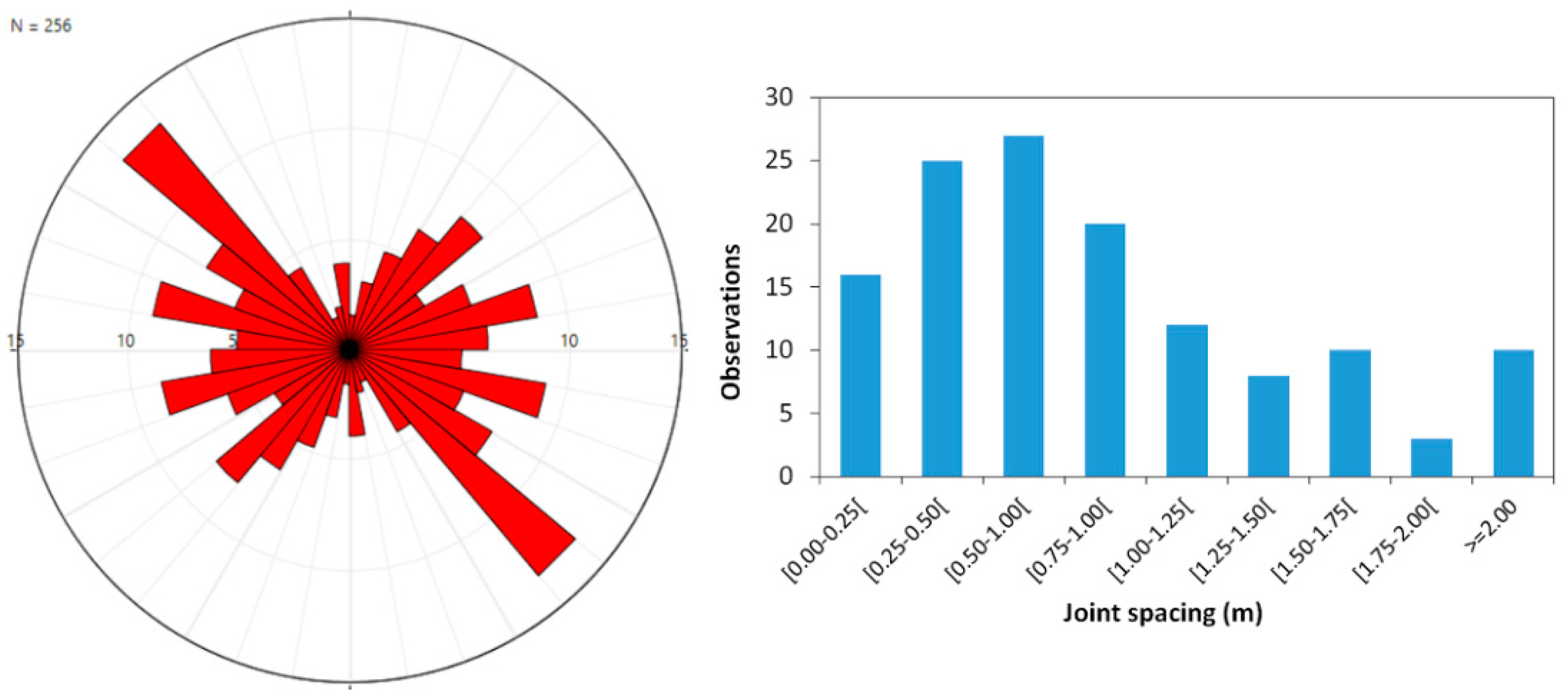
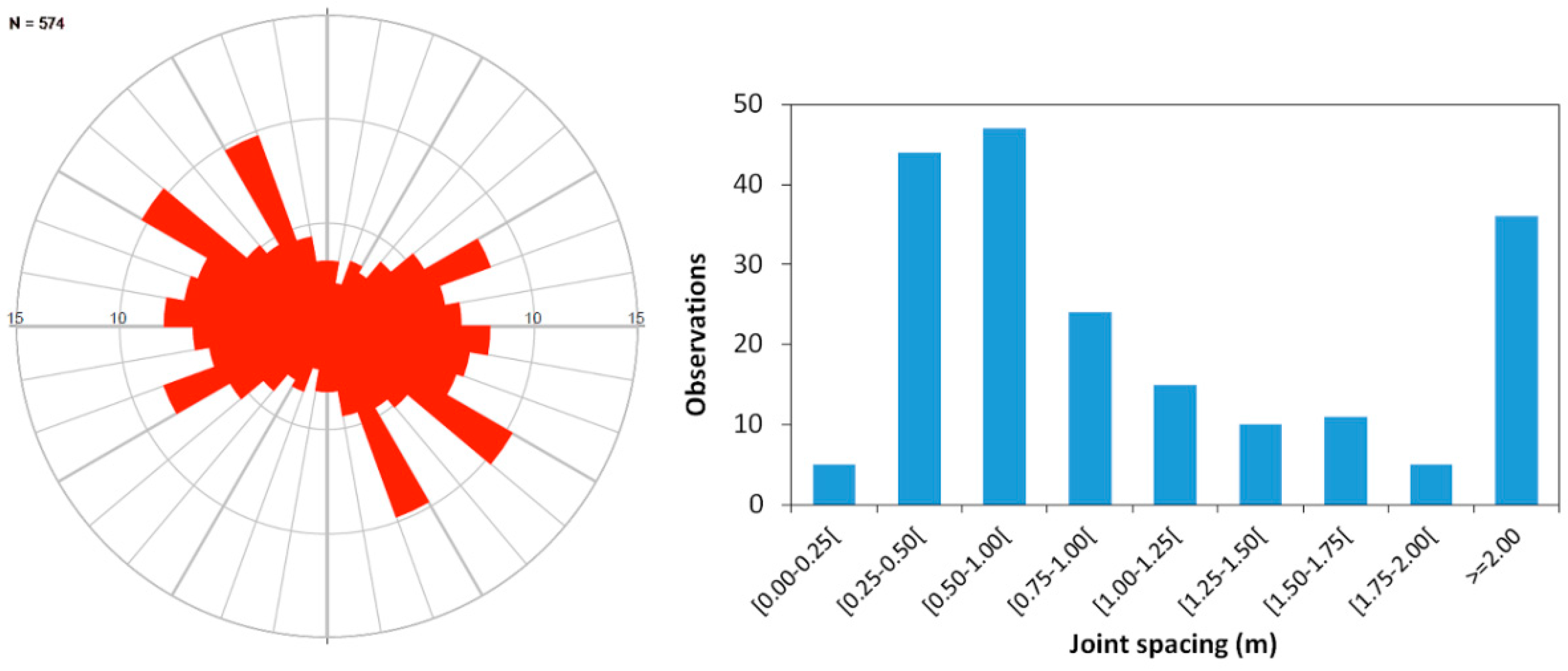
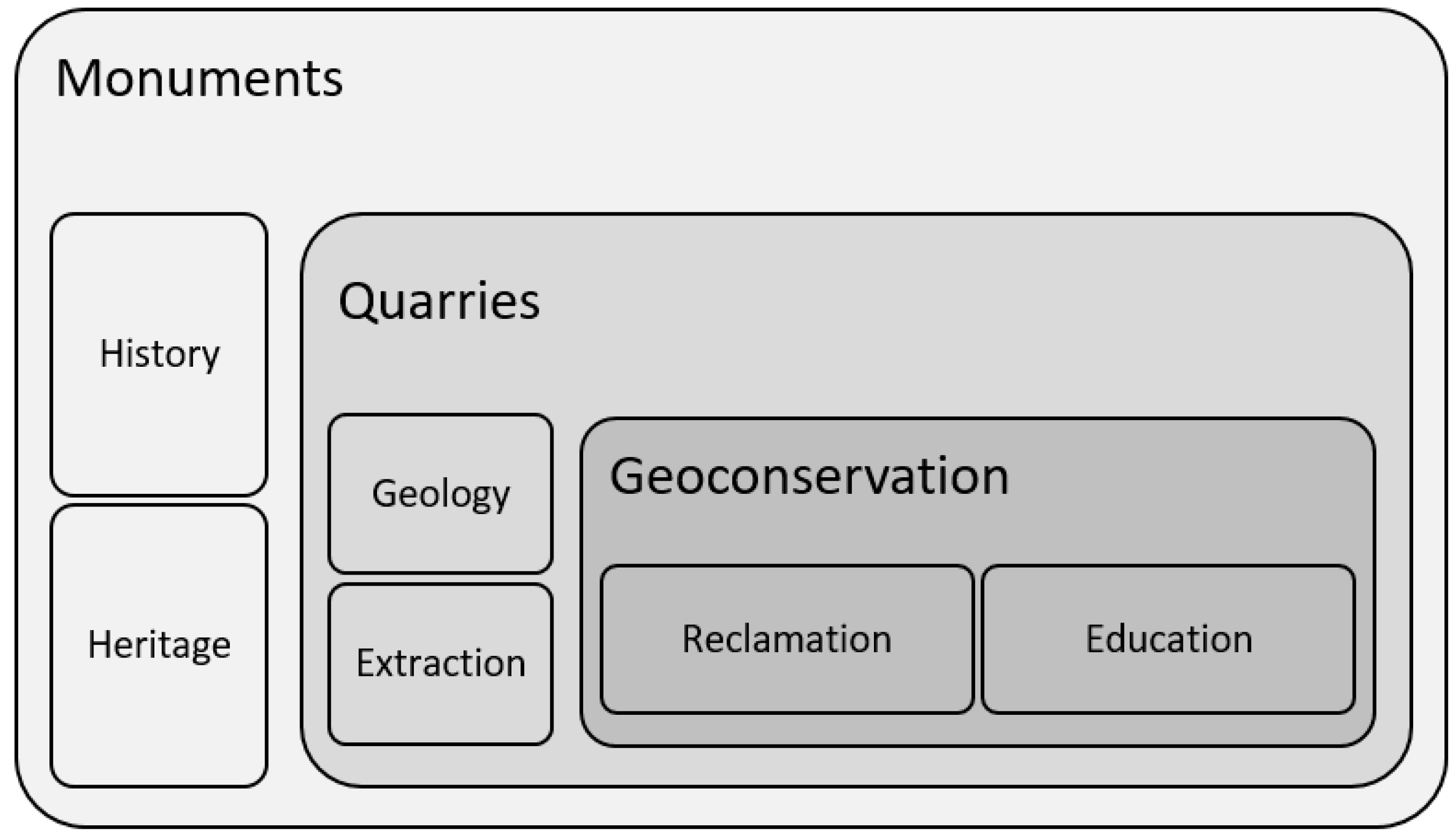
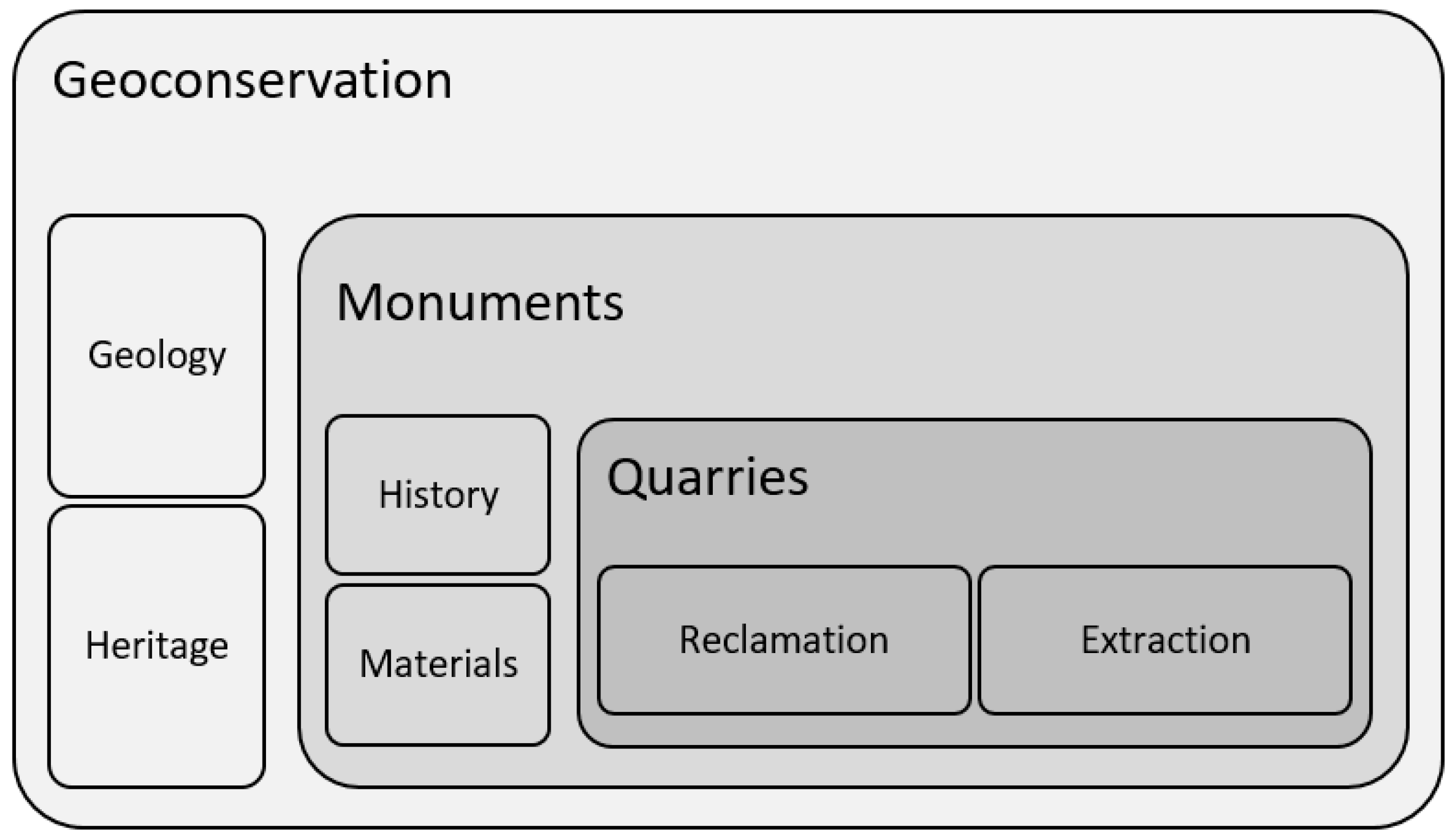
| Testing | Compressive Strength | Flexural Strength | Water Absorption |
|---|---|---|---|
| Martinamor Granite | 161–252 MPa | 12.7–25.3 MPa | 0.9–0.24% |
© 2019 by the authors. Licensee MDPI, Basel, Switzerland. This article is an open access article distributed under the terms and conditions of the Creative Commons Attribution (CC BY) license (http://creativecommons.org/licenses/by/4.0/).
Share and Cite
Sousa, L.; Lourenço, J.; Pereira, D. Suitable Re-Use of Abandoned Quarries for Restoration and Conservation of the Old City of Salamanca—World Heritage Site. Sustainability 2019, 11, 4352. https://doi.org/10.3390/su11164352
Sousa L, Lourenço J, Pereira D. Suitable Re-Use of Abandoned Quarries for Restoration and Conservation of the Old City of Salamanca—World Heritage Site. Sustainability. 2019; 11(16):4352. https://doi.org/10.3390/su11164352
Chicago/Turabian StyleSousa, Luís, José Lourenço, and Dolores Pereira. 2019. "Suitable Re-Use of Abandoned Quarries for Restoration and Conservation of the Old City of Salamanca—World Heritage Site" Sustainability 11, no. 16: 4352. https://doi.org/10.3390/su11164352
APA StyleSousa, L., Lourenço, J., & Pereira, D. (2019). Suitable Re-Use of Abandoned Quarries for Restoration and Conservation of the Old City of Salamanca—World Heritage Site. Sustainability, 11(16), 4352. https://doi.org/10.3390/su11164352






